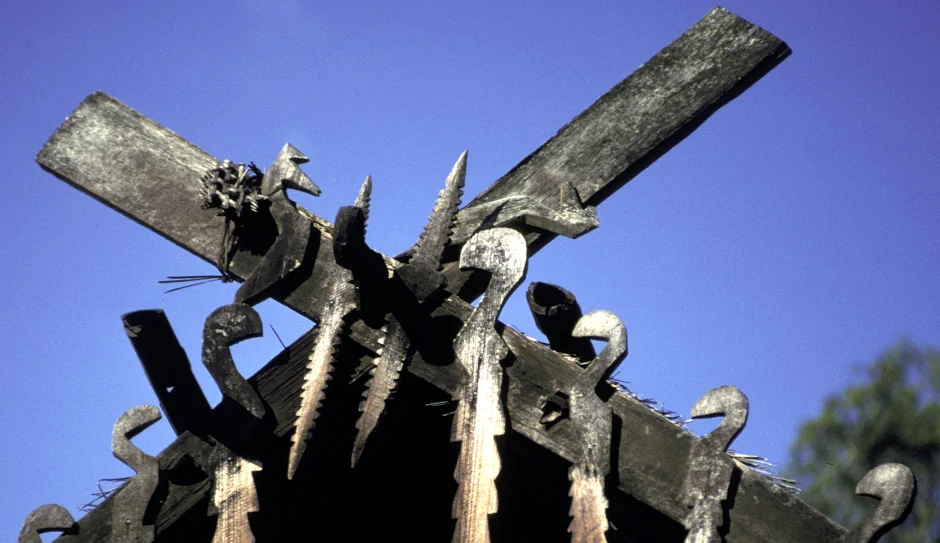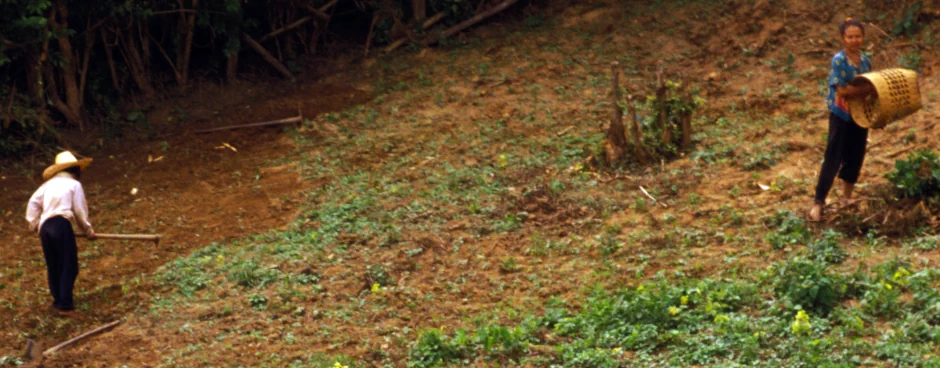The Indigenous Akha People
Ethnonyms: Ahka, Aini, Ak'a, Aka, Ekaw, Hka Ko, Ikaw, Ikor, Kaw, Kha Ko, Khako, Khao Ikor, Khao Kha Ko, Ko, Yani Countries inhabited: Burma (Myanmar), China, Lao PDR, Thailand, Vietnam Language family: Tibeto-Burman Language branch: Lolo
The Akha people are the most spiritual I have ever come across. That is remarkable because of the pressures they face to conform to the modern world. This Akha spiritual leader had a profound effect on me. ('Spiritual leader' is the most accurate term in English; similar terms like 'chief,' 'elder,' 'medicine man,' 'witch doctor,' 'shaman' and 'priest' do not accurately express the role of the Akha spiritual leader.)
When I arrived in his village, I asked my guide to request that we be taken to see their leader. A few minutes later, as we approached his house, he was sitting on a small stool on the porch outside. He appeared very content and almost in a trance state. He signaled us to join him. I spoke none of his languages, nor he mine. What followed instead was a thirty-minute "conversation" between the two of us conducted entirely in sign language. Somehow (I can offer no explanation), we understood each other the whole time.
The visitor to an Akha village could easily be fooled as to the spiritual significance of their daily life. In the August to September time frame, children are seen in every village appearing to be playing on a large swing. This may look no different from the scene you've witnessed hundreds of times in your local park, or even in your own back yard. Not simply a child's recreational pastime, this is the annual swing ceremony. It is an Akha ritual in which thanks are given to the spirits of dead ancestors. So important is this ritual that the village swing is built anew each year just for the occasion.
Worshipping their ancestors forms a key part of Akha spiritual life. They believe that ancestral spirits can influence both the daily life and the long-term fortunes of the living. For this reason, most Akha to this day learn by heart the names of their male ancestors. Today, that lineage goes back about sixty generations. During the most important ceremonies, the list is recited in its entirety. Another reason for knowing this lineage is the role it plays in the incest taboo: If a male and a female Akha find a common male ancestor from the last six generations, they are not allowed to marry.
Entering an Akha village you will see a wooden frame looking like it's either waiting for a door to be made, or its previous door has been removed. Be careful about walking through or touching it because this is the "spirit gate". If you look closer you'll see assorted carvings around the frame — some of them looking appealing, others grotesque. This is by design, as the purpose of the gate is to prevent evil spirits from entering the village while inviting in the benign ones.
Should an evil spirit manage to enter an Akha village, another barrier stands in the way of it entering any household. Look up to the roof of the house and you'll see any number of elaborate, ornate wooden carvings. Their purpose is to protect the house and its dwellers — the more carvings the stronger the protection.
To some, this may seem like simple superstition — especially in the Twenty-first Century, but many Akha — particularly the older generation — believe in this spirit world and live by their belief. An illustration of just how deep and powerful their belief can be is provided by Gordon Young in the final chapter of his book, Tracks of an Intruder.
Traveling with his Lahu companions, Young had come across an Akha village in which a young girl had been sick for some weeks. The timing of their arrival was unfortunate and the girl died shortly afterwards. The Akha villagers believed that evil spirits had entered their village "riding on the back" of Young, and blamed him for her death. Seeking revenge, they planned to kill him. He plotted to save his life by speaking to them in the only terms he knew they would understand: "Akha Chief and all men! Listen carefully to words that will mean the life or death of every one of you! Your intentions are evil, so I call upon my ten thousand guardian spirits to kill you all, every one, even the chickens, pigs and dogs! Command your people to drop their guns immediately or I call the spirits this moment!"
The bluff was effective and without it he probably would have been killed. Despite the event he describes taking place during the 1950's, after having visited many Akha villages, I can easily imagine such a scene being repeated today.
The Akha are originally from China, where most of them still live today. Over the last few hundred years, though, they have migrated into Burma (Myanmar), the Lao People's Democratic Republic, Thailand and Vietnam. Throughout their migration they have continued their traditions and passed on by word-of-mouth their account of their origin, their customs and their history across many generations.
It should come as no surprise that the Akha have achieved this even without access to a written language. In their book Peoples of The Golden Triangle, Paul and Elaine Lewis characterize them by their "desire for continuity" — continuity of their way of life. This continuity can be seen to a large extent in Akha villages to this day. Despite having had a lot of contact with missionaries over the last hundred years or so, those Akha who are considered Christian or Buddhist are, for the most part, only nominally so. In reality, their belief in and connection to their traditional spirit world pervades their daily life.
The desire for continuity may not be waning, but, slowly, the continuity itself is. One sees in most Akha villages today only the oldest generation in their traditional clothes. While the younger generation don these clothes for special ceremonies such as funerals, you are more likely to see them in areas that have heavy volumes of tourists — particularly in northern Thailand. Among the financially poorest of people in each of the countries where they live, the Akha have recently adapted to tourism by selling both their handicrafts and their services as photo opportunities. "Hill tribe trekking" has become very popular in northern Thailand, where it is easy to join a group for a one- to six-day tour of Akha and other ethnic minority villages.
In particular, the area around the Golden Triangle (where Thailand, the Lao PDR and Burma are bordered together) is filled daily with Akha (and other indigenous) children posing, singing and dancing to put food on the table. Most tourists don't realize that many of these children are actually orphans from an orphanage established in a nearby Akha village.
In the Lao PDR, the volume of tourism is much lower, so the same kind of scene is not repeated there. In April, 2001, I found myself in an Akha village there which, although it had seen a small trickle of Western visitors in the past few years, the villagers had never before seen anyone with black skin. (The village did not have electricity so they had not even seen a black-skinned person on television.)
At first they were very unsure of this lady — one child ran to the arms of his mother in genuine fear. Eventually, curiosity won over. Once one of the older children had, with trepidation, touched her skin, one by one the others followed touching her hair also. She was very accommodating as they verified that she posed no threat to them. In the end, everyone laughed at their initial hesitation.
This encounter could have taken place in northern Thailand twenty or so years earlier, but today it would pass without any attention paid to the color of the tourist's skin.
Some breaks in their "continuity" are more welcomed than others by the Akha. Access to education, medicine, hygiene and sanitation, although a recent development, is generally perceived positively. It is not always implemented in the most effective way: The photograph below, showing children washing dishes inside a pig pen, is not an uncommon sight.
One sees the practice of swidden, or "slash-and-burn" agriculture less often. In former times, a village would be relocated every few years, once the land was no longer able to sustain food requirements. (Paul and Elaine Lewis give a fascinating account of how the Akha consult the spirits for permission to relocate a village.) These days, more sustainable agricultural techniques are practiced so that a village may remain at the same site for a decade or more.
Changing agricultural practices also means changes to the kinds of crops grown. Some reports claim that the cultivation of opium poppy by the Akha is on the decline. Of course, it is difficult to get reliable data. One observation, which I have also seen, is the now-common recreational use of opium where it once played a role primarily in Akha ritual.
Tourism may be a part of the explanation as Western "drug tourists" visit Akha villages and take opium recreationally. Whatever the factors that have led to it, the high incidence of opium addiction is currently devastating the lives of many Akha families.
Things are changing for the better, though. The Thai Akha village of Doi Chang is a success story that shows how this trend can be reversed. I did volunteer work in an Akha village near Doi Chang many years ago and learned of the story by chance.
Under a government-funded program the Doi Chang villagers were encouraged to grow coffee in place of opium poppy. It was a gamble that paid off. Doi Chaang coffee is now recognized as one of the best gourmet coffees in the world. The estate and its operation are controlled largely by the local Akha community even today. In fact (my personal opinion), drinking a correctly-made Doi Chaang iced coffee on a hot day is a spiritual experience that should not be missed.
As the Akha are exposed to the modern world, the changes they are facing are sometimes beneficial but other times threatening to their survival. Large numbers of Akha are now leaving their villages in search of greater prosperity in the cities of the mainstream societies where they live.
Typically with little formal education, and often not able to speak the national languages very well, they are met with discrimination and are presented few opportunities. Many of them fall into crime, prostitution and drug addiction. Hopefully, through the work of educators and humanitarian organizations, this trend can be altered and the promise of a better future fulfilled.
Photography copyright © 1999 - 2025, Ray Waddington. All rights reserved. Text copyright © 1999 - 2025, The Peoples of the World Foundation. All rights reserved.

Waddington, R. (2002, revised edition 2023), The Indigenous Akha People. The Peoples of the World Foundation. Retrieved December 18, 2025, from The Peoples of the World Foundation. <https://www.peoplesoftheworld.org/text?people=Akha>
Web Links Spirits in the Akha Forest (short film on YouTube) Virtual Borders Doi Chaang Coffee Books Grunfeld, F. V., (1982) Wayfarers of the Thai Forest: The Akha. Amsterdam: Time-Life Books. Goodman, J. (1996) Meet the Akha. Bangkok: White Lotus.














